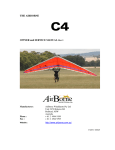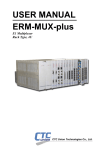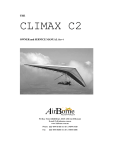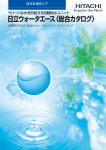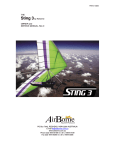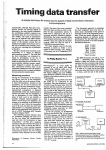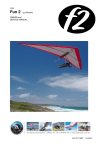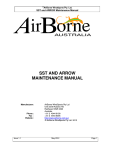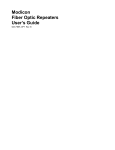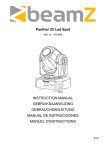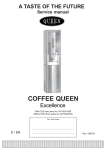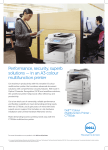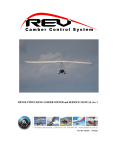Download THE OWNER/SERVICE MANUAL
Transcript
THE SHARK OWNER/SERVICE MANUAL by AirBorne AirBorne WindSports Pty Ltd 22/30 KALAROO RD, REDHEAD 2290 NSW, AUSTRALIA TEL(02) 49 449 199 FAX(02) 49 449 395 e-mail [email protected] AirBorne WindSports- Shark MANUAL TABLE OF CONTENTS Section 1 DESIGN FEATURES4 Section 2 SPECIFICATIONS6 Section 3 OPERATING LIMITATIONS7 Section 4 WARRANTY STATEMENT8 Section 5 ASSEMBLY PROCEDURE9 Section 6 PRE-FLIGHT INSPECTION11 Section 7 BREAK DOWN PROCEDURE 13 Section 8 ASSEMBLY FROM SHIPPING LENGTH14 Section 9 FLIGHT TECHNIQUE15 Section 10 TUNING17 Section 11 PERIODIC INSPECTIONS and MAINTENANCE20 Section 12 TRANSPORTATION AND STORAGE23 Section 13 MAINTENANCE RECORD24 Section 14 HANG GLIDER COMPLIANCE SCHEDULES25 Section 15 ASSEMBLY DRAWINGS28 Issue Date: 14 June 1995 Page 4 AirBorne WindSports- Shark MANUAL Section 1 DESIGN FEATURES The Shark is the latest hang glider from AirBorne Windsports, and is the result of continued testing and refinement by AirBorne’s research and development team. The philosophy behind the development of the Shark was to design a glider which has an increase in all round performance without complicating the set up or compromising the handling characteristics. We believe we have succeeded in all aspects. At a first glance the Shark looks different. The main sail battens are enclosed inside the sail. The battens are tensioned with an internal spring system which not only is faster to load but is much cleaner both aerodynamically and visually. The tip strut requires more tension than the other mainsail battens and utilises an over centre lever to obtain the required tension. The upper and lower surface at the tip has been faired down so that both surfaces meet. The leading edge mylar pocket is wrapped further around the leading edge which improves the surface airflow. Testing has confirmed a performance increase due partly to the increased leading edge wrap. As you start to look closer at the Shark you will find several innovative features inside the sail. The standard VG system which requires the X-Bars to move forward and backward has been replaced by a cam system which operates at the X-Bar leading edge junction. The cam plate is operated by a wire which runs to the nose of the glider. The plate pivots around the X-Bar and pushes the leading edge out which tightens the sail. Several advantages are gained from the X-Bar cam system: The side wire attachment point is inboard of the cam which allows the side wires to be tight in all VG settings. Tight rigging is a major benefit during launch and general ground handling. The cross bar centre hinge point can be moved further back as it is not required to move for the VG system. The result is a stronger compression member because the X-Bars are straighter and slightly shorter. Straighter cross bars also reduces the load on the pull back wire which results in easier tensioning. The X-Bar junction also has a ball and socket system which increases the cross bar strength by removing the acentric loads caused by the X-Bar hinge. Our new X-Bar and leading edge geometry allow the top of the control bar to be moved rearward approximately 150mm whilst still allowing the glider to be assemble flat on the ground. Moving the top of the control bar back improves the static balance and also improves the flair authority. Imported 7075-T6 Aluminium is used in the airframe construction of the Shark. The battens are also made from 7075-T6 aluminium which require almost no maintenance. The overall result is a very strong glider with minimum weight. The Shark retains the tapered fibreglass rear leading edge with a 60mm 7075 front leading edge which provides an extremely stiff leading edge at the X-Bar junction out to the mid span region. The tapered fibreglass rears allows optimum flex at the tip. Pitch stability has been achieved using a 2 x 2 split luff line system to minimize drag and an internal dive stick constructed from carbon fibre. The carbon dive stick is extremely strong and light weight. Issue Date: 14 June 1995 Page 5 AirBorne WindSports- Shark MANUAL The Shark maintains all the fast set-up features which have become a trade mark of AirBorne hang gliders. It can, as with all AirBorne gliders, be assembled flat or on the control frame. AirBorne's quality assurance program,which is unique to the industry, ensures that every glider is built in accordance with the standard it was designed to. This gives even the most experienced pilot a sense of security when flying an AirBorne glider. We hope that you have hours of great flying with your new glider. Fly high and safely. Rick Duncan, Russell Duncan, Shane Duncan, Rob Hibberd and Paul Mollison AirBorne WindSports Issue Date: 14 June 1995 Page 6 AirBorne WindSports- Shark MANUAL Section 2 SPECIFICATIONS SHARK 132 SHARK 144 SHARK 156 METRIC IMPERIAL METRIC IMPERIAL METRIC IMPERIAL SAIL AREA 12.3 sq meter 132 sq ft 13.4 sq meter 144 sq ft 14.6 sq meter 156 sq ft WING SPAN 9.36 30.70 feet 9.71 m 31.86 feet 10.36 m 34.00 feet ASPECT RATIO NOSE ANGLE 7.2 7.2 7.3 128 degrees 128 degrees 128 degrees 82% 82 % 82 % 29 29 31 DOUBLE SURFACE % BATTENS GLIDER WEIGHT 28 kg ASSEMBLY TIME 62 pound 32kg 7 min 71 pound 35 kg 7 min 77 pound 7 min PACK UP LENGTH 5.3 meter 17.39 feet 5.5 meter 18.05 feet 5.9meter 19.4 feet SHORT PACK LENGTH 3.7 meter 12.14 feet 3.9 meter 12.80 feet 4.2 meter 13.77 feet RECOMMENDED PILOT HOOK IN WEIGHT RANGE (Includes Equipment) 50-85 kg 110-187 pounds 65-105 kg 143-232 pounds 80-125 kg 176-276 pounds MINIMUM SPEED (At max recommended weight) 40 km/h 25 mph 40 km/h 25 mph 43 km/h 27 mph MAXIMUM SPEED (At min weight) 71 km/h 44 mph 78 km/h 48 mph 79 km/h 49 mph VNE (Velocity Never to Exceed) 85 km/h 53 mph 85 km/h 53 mph 85 km/h 53 mph VA ( Maximum rough air manouvering speed) 74 km/h 46 mph 74 km/h 46 mph 74 km/h 46 mph Conversions: * 2.205kg/pound * 25.4mm/inch * 1.609km/mile * Va = Test speed x .707 * Vne = Test Speed x.816 Issue Date: 14 June 1995 Page 7 AirBorne WindSports- Shark MANUAL Section 3 OPERATING LIMITATIONS WARNING Hang Gliding is a high risk sport. The safe operation of this hang glider ultimately rests with you, the pilot. We believe that in order to fly safely you must maturely practice the sport of hang gliding. You should never fly this hang glider beyond the placarded limits. The velocity never to exceed (VNE) for your glider is given in Section 2, as is the maximum speed for manoeuvres or flying in rough air (VA). The indicated airspeeds given are for calibrated instruments mounted on, or near, the base bar of the control frame. During your initial flights on the glider it is recommended that you fly with an airspeed indicator until you are able to recognise the control feel that produces the airspeeds shown. Flight operations should be limited to non-aerobatic manoeuvres where the pitch angle does not exceed 30 degrees up or down to the horizon and where the bank angle does not exceed 60 degrees. Aggressive stalls and spins should not be attempted. Operations outside the recommended flight envelope, such as aerobatic manoeuvres or erratic pilot technique may ultimately produce equipment failure. Your glider was designed for foot launched soaring and should not be flown by more than one person at a time. It should not be flown backwards or inverted. The setting up and breaking down of a hang glider, transportation on cars and flying itself, will have an effect over time on its structural integrity. The glider will require maintenance as outlined in the maintenance section of this manual. Like any aircraft safety depends on a combination of careful maintenance and your ability to fly intelligently and conservatively. The owner and operator must understand that due to inherent risks involved in flying a hang glider, no warranty of any kind is made or implied against accidents, bodily injury and death, other than those which cannot by law be excluded. We hope that your new glider will provide you with many hours of safe flying. AIRBORNE. Issue Date: 14 June 1995 Page 8 AirBorne WindSports- Shark MANUAL Section 4 WARRANTY STATEMENT This warranty extends to new Hang Gliders and/or accessories and equipment manufactured by AIRBORNE WINDSPORTS PTY LTD ("Airborne") and shall not embrace any other accessories or equipment in the sale. AIRBORNE warrants to the customer the hang glider and/or accessories manufactured or supplied by AIRBORNE to be free from defect in material and workmanship under normal use and service and of merchantable quality and fit the purpose for which they are ordinarily used. This Warranty will apply for a period of ninety (90) days from the date of dispatch of the hang glider not withstanding the number of hours flown but subject to the hang glider remaining the property of the customer. This warranty does not exclude any rights implied in favour of any customer by any applicable Federal and State legislation. AIRBORNE will make good any parts required because of defective material or workmanship as set out in the Warranty. THE WARRANTY WILL NOT APPLY TO: * Any mechanical adjustments, parts, replacements, repairs or other servicing that in the judgement of AIRBORNE are made or should be made as maintenance. * Any defect caused by any alteration or modification not approved by AIRBORNE. * Any defect caused by the fitment of parts that are not made or approved by AIRBORNE. * Any defect caused by misuse, accidents, negligence or failure to carry out proper maintenance service. * Damage caused by continued operation of the hang glider after it is known to be defective. * Any defect or consequential loss, damage or injury caused by overloading. * Loss of use of the hang glider, loss of time, inconvenience, damages for personal injuries, loss of property or other consequential damages. * Failure due to wear and tear, accident, fire, incorrect or incomplete rigging and/or assembly, exposure to the elements, operation outside the placarded limitations and repairs attempted or made other than by AIRBORNE or its authorised agent. AIRBORNE will replace, free of charge, any original part that is determined by AIRBORNE to be defective under the terms of this Warranty and reserves the right to pay monetary compensation or make good the defect in any manner it deems appropriate. The customer is responsible for transporting the hang glider or parts to and from AIRBORNE or its authorised agent when making claims under this Warranty. The hang glider or parts are at the customer's risk whilst in transit to and fromAIRBORNE or its authorised agent. NOTE: Warranty service is available to the customer from AIRBORNE WINDSPORTS PTY LIMITED or authorised agent. AIRBORNE WINDSPORTS Issue Date: 14 June 1995 Page 9 AirBorne WindSports- Shark MANUAL Section 5 ASSEMBLY PROCEDURE The wing can be assembled in two positions, either lying flat or standing on the control frame. Assembling the Shark on the control frame is the most popular method of assembly in light winds. This method is preferable as the sail is less prone to being soiled or damaged during assembly. In higher winds it is preferable to lay the glider flat for assembly with the nose into the wind until ready to launch. Our suggested sequence is as follows: 1) UNZIP THE BAG. Lay the wing down with zip up and the nose facing approximately 120 degrees from the wind direction. The nose should be facing into the wind when assembling flat. Unzip the bag and un clip centre ties. 2) ASSEMBLE CONTROL FRAME. Spread the control bar down tubes and attach base bar to knuckle. The pip pin is then inserted with the cover firmly secured. Check that all the rigging wires are outside the control frame. 3) STAND GLIDER UP. Rotate the control frame to the vertical position and rotate the wing 180 degrees so that it is sitting on the base bar. If assembling flat ensure that control bar is central and the wires are not tangled. 4) REMOVE BAG. Remove the glider bag and un clip remaining ties. 5) SPREAD LEADING EDGES. Carefully spread both leading edges out half way then spread leading edges to their approximate flying position. IT IS ESSENTIAL THAT THE KEEL AND THE LEADING EDGES ARE KEPT IN THE SAME PLANE OR DAMAGE WILL RESULT. 6) RAISE KING POST. Raise the kingpost and attach the reflex bridles. 7) INSERT MAINSAIL BATTENS. Remove the battens from the bag. The red battens are for the left side and the green for the right. Insert the battens from the centre to the tip with gentle pressure, until the batten meets resistance. Shake the sail at the trailing edge whilst maintaining gentle pressure on the batten to allow the batten to be inserted over the cross bar. DO NOT FORCE THE BATTENS! Locate batten in to sail pocket. It is advised not to insert the last cambered tip batten and tip strut until the cross bars are tensioned. 8) TENSION CROSS BARS. The cross bars are now tensioned by pulling the webbing loop until the shackle is positioned on the Quick Clip. Ensure that the catch is positively locked. When tensioning the glider lying flat the keel can be raised slightly allowing the side flying wires to become looser. 9) ATTACH REAR TOP WIRE. The rear top wire should now be attached to the 10) LOAD TIP STRUTS. Insert the tip battens and tension tip struts. The tip strut should be located on to the webbing loop on the trailing edge. The centre of Issue Date: 14 June 1995 Page 10 rear Quick Clip blo AirBorne WindSports- Shark MANUAL the strut is now pushed towards the centre of the glider to tension. 11) ATTACH FRONT FLYING WIRES. The ring on the front flying wires can now be inserted in to the Quick Clip Block. Ensure that the catch is positively locked. If the glider has been assembled flat it should now be lifted on to the control frame. Be aware of the tip battens! Make sure you have a firm grip on the keel when raising the nose from the flat position in strong winds. 12) INSERT UNDER SURFACE BATTENS. (The rear keel can be popped off and used to lift the rear of the glider in light wind conditions)The under surface battens should be inserted past the hole in the sail and then pulled backwards to the rear of the pocket 13) INSERT NOSE BATTEN. Insert the nose batten tail end first and locate it on the fitting on the front of the keel. A visual check of the variable geometry system is advisable at this point. 14) INSTALL NOSE FAIRING. Attach the nose fairing applying the top velcro first then gently tension over the nose plates and attach the velcro to the undersurface. 15) PREFLIGHT INSPECTION. You are now ready for the wing pre-flight inspection as outlined in the next section. It is imperative that you carry out this inspection every time you rig and before you fly. Issue Date: 14 June 1995 Page 11 AirBorne WindSports- Shark MANUAL Section 6 PRE-FLIGHT INSPECTION A thorough pre-flight inspection is mandatory for any aircraft, and the best technique is a circular walk around the wing. The nose area is the ideal place to start your pre-flight check, followed by each assembly point. Keep in mind the three most critical set up areas: 1) The nose quick clip 2) Control bar base tube connecters. 3) The cross bar tension quick clip. Starting at the nose we suggest the following checklist (ensuring all bolts and fasteners have the appropriate thread protruding beyond the nut). 1) Check the nose plate assembly ensuring that the king post wire is not kinked. Sight along both leading edges checking for similar curves. 2) Walk towards the tip feeling for dents in the leading edge. 3) Check cross bar/leading edge junction through the zipper access. Check cam plate is in order. Ensure that the pivot bolts are secure. 4) Check sail tip webbing is undamaged and is located properly on the fitting. Ensure tip fitting pins are fully inserted into the tip bung and velcro is in place. 5) Crouch down and lift tip to eye level to inspect that the tip strut and dive stick are properly located and that the rear leading edge is undamaged. 6) Walk towards the keel checking all battens are secured and correctly loaded. 7) Check all luff lines attachments are in order. 8) Check that the cross bar retaining shackle and rear top wire are secured on the quick clip. 9) Check the rear top rigging and that the reflex bridle carabina is properly closed. 10) Check king post base. 11) Repeat steps #2 - #7 for the other side wing in reverse order. 12) Check all lower rigging is correctly routed and free from damage. The most likely area for damage on wires is around the swage and thimble area. 13) Check Control Bar corners are correctly assembled with pip pin and cover in place. 14) Ensure hang loop is secure and in good order. Check attachment point on Issue Date: 14 June 1995 Page 12 AirBorne WindSports- Shark MANUAL 15) King Post. Check control bar top assembly and ensure that the down tubes are straight. 16) Unzip undersurface and check cross bar hinge and retaining strap. Ensure cross bar ball and socket is properly located and cover is not caught in the joint. Operate VG system to ensure it is functioning properly. Check all VG wires are in good order and are not twisted or kinked. 17) Ensure that the double surface is zipped up and the nose fairing is secured. 18) Clip your harness into the main and back up hang loops and perform a "hang check". Make sure that your harness is the correct distance from the base bar, your leg loops are secure and your carabina is locked. 6.0.1 Hang Glider Daily Inspection Inspection of the following items after every assembly of the glider is required: • Check for bends, dents, scratches in all tubes; • Check wire ends for bolt and/or other fastener security; • Check wires for twisted or jammed thimbles; • Check wires are free of kinks, frays, abrasions, broken strands etc; • Nose plate connections; • Tips secure; • Battens secure; • A-frame connections at the top and base on both sides; • Variable geometry operation (full and free movement); • Rear keel connections; • Cross-bar tension wire; • Cross-bar (free floating); • King post connections; • Luff Lines - attached and tension correct; • Sail condition; • Harness straps and webbing secure, height adjustment correct; • Emergency parachute secure, attached and operating handle accessible. Issue Date: 14 June 1995 Page 13 AirBorne WindSports- Shark MANUAL Section 7 BREAK DOWN PROCEDURE To break down your Shark, just reverse the set-up procedure steps as described. Included here are a few guidelines to follow which will save you time and prevent potential wear areas on your sail. It is possible to leave the nose batten in during daily operations! It is, however, important to remove the nose batten from the fitting on the front of the keel. 1) Remove nose fairing. 2) Remove tension from tip strut and remove undersurface battens. 3) Let off the sail tension and pull each wing in slightly. Pull out all main sail battens. 4) Attach top control bar padding. 5) Disconnect reflex bridle and attach rear quick clip padding. 6) Fold both wings in symmetrically, bringing both leading edges back at the same time. Disconnect carbon dive sticks. 7) Roll the sail up from the last luff line. Roll the luff lines into the sail. This will avoid tangling of the luff lines during the set up procedure. One tie should be wrapped around the keel and leading edge to hold them together whilst the other side wing is rolled. 8) Place padding over the end of the keel and quick clip block. 9) Ensure that the sail is rolled into the leading edge pockets. It is important that the ties are not over tensioned as this can damage the mylar insert. 10) Place glider bag in position. 11) Roll glider over, undo control bar pip pin. Fold base bar rearward. Attach base bar padding around down tube base. Place padding over the end of the base bar. Undo the two centre ties and fold the control bar down between the leading edge pockets. Secure the centre ties and zip up bag. For de-rigging flat, attach top control bar padding. Undo nose wires and remove nose fairing. Pull wing forwards then follow steps as above. If resistance is encountered during any phase of set up or break down procedure stop and investigate. Issue Date: 14 June 1995 Page 14 AirBorne WindSports- Shark MANUAL Section 8 ASSEMBLY FROM SHIPPING LENGTH If your Glider was delivered to you in the short pack form the following procedure should be used. 1) Unzip bag and remove ties. Remove all padding from the tube ends. 2) Assemble the control frame as described in the set up procedure section 5 (2). Rotate the glider on to the control bar, lying flat on the ground. 3) Spread both leading edges approximately 1/2 metre. Remove the tip bags which have been used as protection on the rear of the front leading edges. 4) Check rear leading edge bungs for R (right) and L (left). Insert rear leading edges in the appropriate side of the front leading edge with the slot on the rear leading edge facing towards the keel. Push on the leading edge and rotate slightly to ensure it is located correctly. It should be impossible to rotate the leading edge if correctly installed. 5) You are now ready to tension the sail. There are two webbing loops on the tip of the sail. The inside loop is for the sail tension and the red outward loop is used to apply tension to locate the primary sail tension loop. Place one hand on the rear of the leading edge and the other through the red loop. Pull sail firmly until the inside loop is located on the end of the leading edge fitting. Ensure the webbing is centrally located. Secure velcro tabs on the inside of the leading edge. Repeat for the other leading edge. 6) Your glider can now be fully assembled as outlined in the Set Up Procedure. BREAKDOWN FOR SHIPPING Reverse the procedure above ensuring that all possible wear points are padded. Be sure to remove the nose batten from the sail and place in batten bag. Be careful when folding the sail as the mylar leading edge insert may be damaged. When you have finished packing the glider, place the front of the glider bag over the rear of the short packed glider. Zip up bag carefully and place the rest of the bag inside the package. (The bag is installed back to front because it is tapered and the glider is bulkier at the rear when short packed. Issue Date: 14 June 1995 Page 15 AirBorne WindSports- Shark MANUAL Section 9 FLIGHT TECHNIQUE Take Off..Don't forget to hook in... The VG should be in the full off position for launch. The Shark has a slightly tail heavy static balance and is very easy to launch. Hold the nose in a slightly elevated position with the wings level, run hard keeping the nose at the same angle. It is important that the pilot accelerates smoothly during the launch run. A rapid acceleration will cause the nose to rise sharply with the risk of stall on launch. Turns The Shark can be easily directed into a turn even at slow speeds, however for a fast roll rate and easier handling, it is best to pull on a little extra flying speed. The Shark will maintain a turn until the turn is removed by pilot input. Allow yourself plenty of margin for safety. Don't fly too slowly when scratching close to the hill . Stalls When practising stalls make sure you have sufficient altitude. Push out slowly (approx 1 mph per sec. speed reduction), the glider will tend to mush without dropping a wing. The sink rate will increase in this mush mode more than two fold. If you push out faster the nose will pitch higher, this is followed by a gentle pitch down until the glider regains flying speed and recovers from the stall. Never stall the glider with the nose pitched up too high. This is a dangerous manoeuvre and can result in a tail slide and severe tumble. As a guideline, the angle at which the glider stalls is about the same as the angle it will recover. If you push out too much in a turn the glider will turn tighter unless you are flying very slow, in which case you may tip stall. So keep on a little extra speed in turns until you get used to the glider. Spins As with all the later design gliders the Shark will resist spinning. If you do stall a wing in a turn and enter the initial stages of a spin, move your weight forward and to the high side of the rotation and the glider will recover. Thermalling The optimum speed for thermalling is a little above stall speed, it may be necessary to fly faster than this in rough conditions to maintain good control. The VG is usually fully off for thermalling but up to 1/3 VG can be used to make the glider roll in to the turn more for stronger thermals. Depending on the nature and area of the thermal a bank angle of between 10 and 50 degrees can be used. Issue Date: 14 June 1995 Page 16 AirBorne WindSports- Shark MANUAL Landing Landing is easy in the Shark. Your final approach should be a straight glide into the wind faster than trim speed, approx 25 mph (40 km/h). The VG should be in the off position. Reduce air speed slowly keeping wings level. When the glider reaches trim speed a full flare is required. Flare aggressively holding the uprights out and up. It is important that the pilot does not swing the legs forward whilst flaring. This results in the pilot's centre of gravity moving forward which will cause the nose to drop. In strong wind it is possible to fly the glider onto the ground slowing up gradually. Be careful not to push out too hard in windy conditions. Issue Date: 14 June 1995 Page 17 AirBorne WindSports- Shark MANUAL Section 10 TUNING Your Shark was test flown and delivered to you in good trim. If, however, any adjustments are made to your glider, we recommend that they be recorded in your maintenance log at the rear of this manual. If you feel that the glider requires adjustment to trim in the roll or pitch axis you should check that the problem is not caused by something asymmetrical in the frame or battens. In order of priority, check the following: 1) Ensure that the wires, including luff lines, are correctly routed; 2) Check the battens against the profile; 3) Check that the tip struts have the same tension on both sides; 4) Check that the keel is straight; 5) Check that the sail is correctly mounted on the leading edges. 6) Check leading edges are straight and the rear leading edges are located correctly; 10.1 Pitch Trim Standard position of king post is in the middle hole. To make the glider trim faster move the king post base forward one hole on the keel. To trim slower move the king post base rearward one hole. A heavier pilot may make the glider trim slower than a lighter pilot. The heavier pilot causes an increase in twist through extra leading edge flex. The king post should be moved forward one hole. Issue Date: 14 June 1995 Page 18 AirBorne WindSports- Shark MANUAL 10.2 Pitch Stability System Stability in the pitch axis is provided by reflex in the root section. Alterations to the lengths of rigging, airframe or adjustments to the airfoil can have adverse effects on pitch stability. Reflex bridles provide pitch stability at low angles of attack. Correct attachment and adjustment of the reflex bridles is essential for maximum stability. A string line can be used to check the reflex bridles are correct. The line should be firmly stretched between the reflex bridle attachment eyelet on corresponding battens on the right and left side of the glider. Check the measurement from the string line to the top of the keel. The glider should be in full VG off configuration standing on the control frame. It is important to support the keel off the ground from the rear flying wire attachment point otherwise the keel will flex and the measurements will be incorrect. String tension and measurement technique will also give small variations of +/- 10 mm. This tolerance should be considered when checking against the chart below. Bridle Checking Specifications Issue Date: 14 June 1995 Page 19 AirBorne WindSports- Shark MANUAL 10.3 Roll/Yaw Trim Through time and use it is possible that you glider may become "unbalanced". The glider may turn one way or roll into a bank easier in one direction than the other. It is possible that the cloth may stretch asymmetrically if the pilot, over an extended period of time, consistently thermals in one direction. Hard landings or high "G" loads may also cause abnormal cloth stretch. There are a couple of methods which can be used to remedy a turn in your glider. It is important that you check the points 1 to 6 at the beginning of this section before attempting the following adjustments. 1) TIP PLUG ADJUSTMENT. The tip plug can be rotated to increase or decrease lift on either wing. To remove a persistent turn the fast wing should have the tip fitting rotated upward to decrease the lift on that side. To remedy a right hand turn, for example, rotate the left hand tip fitting anti-clockwise if viewed from the rear of the leading edge. The tip fitting should be rotated a maximum of two holes from the standard position. The right side can be rotated anti-clockwise if the turn persists. Ensure that the clevis pin is inserted fully after adjustment and that the pin is secured with duct tape. Secure the sail velcro. 2) DIFFERENTIAL TIP STRUT TENSIONING. The tension can be increased on the tip strut to remove a turn. The increase in tension flattens out the sail which causes more lift. This should be attempted on the slow wing. To remedy a right hand turn, for example, the strut tension should be increased by the following technique: Undo lock nut and rotate the strut in a counter clockwise direction (Max 5 rotations). The lock nut should now be tensioned. Do not over tighten lock nut as the plastic fitting may be damaged. For a left turn the left strut should be rotated counter clockwise to increase tension. The over centre lever on the tip strut can apply high loads to the sail because of the extra mechanical advantage of the system. Do not over tension the strut. ( For factory standard length see drawing A4-4540 at the rear of this manual) . NB If the glider turns to the right we refer to the right wing as the slow wing. Issue Date: 14 June 1995 Page 20 AirBorne WindSports- Shark MANUAL Section 11 PERIODIC INSPECTIONS and MAINTENANCE 11.1 Maintenance Schedule 1 - Clean and service, 2 - Check as directed, 3 - Check for security, cracks, wear and faulty operation, 4 Remove, inspect and replace if necessary, 5 Recommend replacement or overhaul. MAINTENANCE REQUIREMENT Maintenance Period Period > Daily Monthly Flying Days > 1 Three Six Months Monthly Every Year Every 2 Every 4 Years Years 10 30 50 100 200 400 Wing Fabric deterioration and tears 2 2 2 2 4 5 Wing Fabric Stitching 2 2 2 2 2 Wing Fabric attachment points 3 3 3 3 3 3 Batten Elastics 3 3 3 3 4 4 Check Battens against template supplied 2 2 2 2 2 2 3 3 4 4 5 5 2 2 2 4 4 4 2 4 4 4 Wing wires and attachment fittings 2 Check leading edges, keel & A Frame for straightness, dents and corrosion Remove leading edges, cross bar, keel & A Frame structural members and check for fatigue cracks radiating from drilled holes. Check reflex bridle luff lines for kinks 2 2 2 2 2 2 2 2 2 2 2 2 2 3 3 3 4 4 5 All bolts, nuts, washers & safety pins. At least one thread showing outside each nut. 2 2 2 2 2 2 Check hang straps and karabiners for wear or damage 2 2 2 4 5 5 Check Saddles and fittings for cracks 2 2 2 4 4 5 Check Inspection Zips Check Variable Geometry pulley and Cam plates and cleats 2 Check Security of King Post Base. 2 2 2 2 2 2 2 Check Bottom Down Tube fitting and security of grub screws 2 2 2 2 2 2 2 It is recommended that: (a) those items marked 1,2 and 3 be performed by the owner of the glider; (b) those items marked 4 be performed by the owner in conjunction with another pilot; and © those items marked with a 5 should be performed by Airborne or an accredited Airborne service agent. Log Book When maintenance is performed always check appropriate square and make an entry in the maintenance log at the rear of this manual. Issue Date: 14 June 1995 Page 21 AirBorne WindSports- Shark MANUAL 11.2 Notes on Periodic Inspections 11.2.1 Airframe Tubing 11.2.1.1 Installation & Removal When removing tubing do not bend or force tubes. When installing do not distort tubing from its original shape. 11.2.1.2 Inspection Inspect tubing for cracks, damage from abrasion, elongated holes or distortion in tube surface. Never attempt to repair tubing, always replace with new part. Inspect tubing for corrosion in and out. If corrosion is present the component should be replaced. 11.2.1.3 Replacement Aluminium tube comes in many different sizes and grades. It is important that the correct replacement parts are used. 11.2.2 Bolts 11.2.2.1 Installation & Removal • After tightening, all bolts should have at least one and a half to two threads showing. • All self-locking nuts should not be installed more than two times. • Be sure not to over-torque bolts when installing. 11.2.2.2 Inspection • Check bolts for worn shanks, bad threads or corrosion. 11.2.3 Sails Sail Inspection • Check for tears in the sail cloth or any loose or unravelled seams. • Check all inspection zippers to see if they function smoothly and close completely. • Inspect tip webbing for damage. The sail may be repaired with appropriate sail tape or a sewn on patch. Airborne or an authorised agent should be consulted about sail repairs. Keep the sail clean of oil and dirt by washing the sail with soap and water. Keep the sail covered when not in use. CONTINUED EXPOSURE TO SUN DRAMATICALLY SHORTENS THE LIFE OF SAILS Issue Date: 14 June 1995 Page 22 AirBorne WindSports- Shark MANUAL 11.3 Inspection after Hard Landing It is necessary to do a detailed inspection following any unusual stressing of the Hang Glider this full inspection should include all details listed for six monthly maintenance. The inspection should be noted in the log book, and any replacement to be recorded. 11.4 Defect Reports Details of any defect which develops in service and which, if kept uncorrected, would compromise the continued safe operation of the hang glider should be reported to Airborne as soon as practicable. Issue Date: 14 June 1995 Page 23 AirBorne WindSports- Shark MANUAL Section 12 TRANSPORTATION AND STORAGE Avoid damage to your glider by using well padded racks. We recommend that you support the glider in at least 3 places to spread the load. Flat straps should be used for tie downs to avoid damage to leading edge mylar. Store the glider in a dry room off the ground. Air the glider out regularly to avoid mildew, and never store wet. SAFE FLYING TEAM AIRBORNE Issue Date: 14 June 1995 Page 24 AirBorne WindSports- Shark MANUAL Section 13 MAINTENANCE RECORD Date Issue Date: 14 June 1995 Details of Repairs or Maintenance Carried out by. Page 25 AirBorne WindSports- Shark MANUAL Section 14 HANG GLIDER COMPLIANCE SCHEDULES 14.1 Shark 132 GLIDER MODEL: Shark 132 MANUFACTURED BY: AIRBORNE WINDSPORTS Pty Ltd NOTE: These specifications are intended only as a guideline for determining whether a given glider is a certified model and whether it is in the certified configuration. Be aware, however, that no set of specifications, however detailed, can guarantee the ability to determine whether a glider is the same model, or is in the same configuration as was certified, or has those performance, stability, and structural characteristics required by the certification standards. An owner's manual is required to be delivered with each HGMA certified glider, and it is required that it contain additional airworthiness information. Metric Weight of glider with all essential parts and without cover bags and non essential parts. Imperial 28. kg 62. lbs Nose Plate anchor hole to crossbar plate attachment hole 3050.mm 120.08" Nose Plate anchor hole to rear sail attachment point 5215. mm 205.31" Outside diameter at nose 60. mm 2.37" Outside diameter at cross bar 60. mm 2.37" Outside diameter at rear sail attachment point 34. mm 1.34" 2778. mm 109.37" 62. mm 2.44" 1135. mm 44.69" 1295. mm 1325. mm 50.98" 52.17" 1640. mm 64.57" 975. mm 38.39" 9360. mm 368.50" Leading Edge Dimensions Crossbar Dimensions Overall pin to pin length from leading edge attachment point to hinge bolt at glider centre line Largest outside diameter Keel dimensions 1 The cross bar centre load bearing pin The pilot hang loop Fwd Rear Sail Dimensions Chord length at 3 ft outboard of centre line Chord length at 3 ft inboard of tip Span (extreme tip to tip) Location of Information Placard Cross Bar Location of Test Fly Sticker Recommended Pilot Hook in Weight Range Recommended Pilot Proficiency 1 Front Keel 50-85 kg 110-187 lbs Int/Adv Hang 3/4 least and greatest allowable distances, whether variable through tuning or through in-flight variable geometry, from the line joining the leading edge nose bolts to: Issue Date: 14 June 1995 Page 26 AirBorne WindSports- Shark MANUAL NB: Conversions 2.205kg / pound - 25.4 mm / inch Issue Date: 14 June 1995 Page 27 AirBorne WindSports- Shark MANUAL 14.2 Shark 144 GLIDER MODEL: Shark 144 MANUFACTURED BY: AIRBORNE WINDSPORTS Pty Ltd NOTE: These specifications are intended only as a guideline for determining whether a given glider is a certified model and whether it is in the certified configuration. Be aware, however, that no set of specifications, however detailed, can guarantee the ability to determine whether a glider is the same model, or is in the same configuration as was certified, or has those performance, stability, and structural characteristics required by the certification standards. An owner's manual is required to be delivered with each HGMA certified glider, and it is required that it contain additional airworthiness information. Metric Weight of glider with all essential parts and without cover bags and non essential parts. Imperial 32. kg 71. lbs Nose Plate anchor hole to crossbar plate attachment hole 3248. mm 127.87" Nose Plate anchor hole to rear sail attachment point 5405. mm 212.80" Outside diameter at nose 60. mm 2.37" Outside diameter at cross bar 60. mm 2.37" Outside diameter at rear sail attachment point 34. mm 1.34" 2963. mm 116.658" 62.mm 2.44" 1120. mm 44.09" 1325. mm 1355. mm 52.17" 53.35" 1740. mm 68.50" 975. mm 38.39" Leading Edge Dimensions Crossbar Dimensions Overall pin to pin length from leading edge attachment point to hinge bolt at glider centre line Largest outside diameter Keel dimensions 2 The cross bar centre load bearing pin The pilot hang loop Fwd Rear Sail Dimensions Chord length at 3 ft outboard of centre line Chord length at 3 ft inboard of tip Span (extreme tip to tip) 9710. mm 382.28" Location of Information Placard Cross Bar Location of Test Fly Sticker Front Keel Recommended Pilot Hook in Weight Range Recommended Pilot Proficiency 65-105 kg 143-232 lbs Int/Adv Hang 3/4 NB: Conversions 2.205kg / pound - 25.4 mm / inch 2 least and greatest allowable distances, whether variable through tuning or through in-flight variable geometry, from the line joining the leading edge nose bolts to: Issue Date: 14 June 1995 Page 28 AirBorne WindSports- Shark MANUAL 14.3 Shark 156 GLIDER MODEL: Shark 156 MANUFACTURED BY: AIRBORNE WINDSPORTS Pty Ltd NOTE: These specifications are intended only as a guideline for determining whether a given glider is a certified model and whether it is in the certified configuration. Be aware, however, that no set of specifications, however detailed, can guarantee the ability to determine whether a glider is the same model, or is in the same configuration as was certified, or has those performance, stability, and structural characteristics required by the certification standards. An owner's manual is required to be delivered with each HGMA certified glider, and it is required that it contain additional airworthiness information. Metric Weight of glider with all essential parts and without cover bags and non essential parts. Imperial 35. kg 77. lbs Nose Plate anchor hole to crossbar plate attachment hole 3498. mm 137.22" Nose Plate anchor hole to rear sail attachment point 5805. mm 228.54" Outside diameter at nose 60. mm 2.37" Outside diameter at cross bar 60. mm 2.37" Outside diameter at rear sail attachment point 34. mm 1.34" 3188. mm 125.51" 62. mm 2.44" 1215. mm 47.83" 1410. mm 1440. mm 55.51" 56.69" 1860. mm 73.22" 975. mm 38.38" 10360. mm 407.87" Leading Edge Dimensions Crossbar Dimensions Overall pin to pin length from leading edge attachment point to hinge bolt at glider centre line Largest outside diameter Keel dimensions 3 The cross bar centre load bearing pin The pilot hang loop Fwd Rear Sail Dimensions Chord length at 3 ft outboard of centre line Chord length at 3 ft inboard of tip Span (extreme tip to tip) Location of Information Placard Cross Bar Location of Test Fly Sticker Recommended Pilot Hook in Weight Range Recommended Pilot Proficiency 3 Front Keel 80-125 kg 176-276 lbs Int/Adv Hang 3/4 least and greatest allowable distances, whether variable through tuning or through in-flight variable geometry, from the line joining the leading edge nose bolts to: Issue Date: 14 June 1995 Page 29 AirBorne WindSports- Shark MANUAL NB: Conversions 2.205kg / pound - 25.4 mm / inch Issue Date: 14 June 1995 Page 30 AirBorne WindSports- Shark MANUAL Section 15 ASSEMBLY DRAWINGS 15.1 Nose Assembly - A4-4515 ID PARTNO DETAILS SK132 FRAME SK144 FRAME SK156 FRAME 1 100631 AN4-31 2.000 2.000 2.000 2 100042 AN4 WASHER 2.000 2.000 2.000 3 100035 AN4 NUT HALF NYLOC 3.000 3.000 3.000 4 102460 NOSE PLATE HANG GLIDER 3MM 2.000 2.000 2.000 5 102271 SADDLE TO SUIT 45MM TUBE 4.000 4.000 4.000 6 106152 QUICK CLIP ASM 47MM L/E 1.000 1.000 1.000 7 102601 KEEL TUBE ASSEM SK144 102644 KEEL TUBE ASSEM SK156 102739 KEEL TUBE ASSEM SK132 102600 L/EDGE FRONT SK144 102639 L/EDGE FRONT SK132 102642 L/EDGE FRONT SK156 9 101055 NYLON WASHER 10 100915 11 8 1.000 1.000 2.000 2.000 2.000 8.000 8.000 8.000 NUT NYLOC M 8 1.000 1.000 1.000 100043 AN5 WASHER 1.000 1.000 1.000 13 102709 SPACER 25D X 12 L 1.000 1.000 1.000 14 102581 VG WIRE CAM TYPE SK132 1.000 102582 VG WIRE CAM TYPE SK144 102596 VG WIRE CAM TYPE SK156 102751 TOP FRNT WIRE HGWR 3110 SK132 102752 TOP FRNT WIRE HGWR 3215 SK144 102753 TOP FRNT WIRE HGWR 3500 SK156 16 102710 SPACER 25D X 6 L 1.000 1.000 1.000 17 102711 SPACER 25D X 4 L 1.000 1.000 1.000 18 100011 AN4-30A 1.000 1.000 1.000 19 102586 SAIL (STANDARD) SK156 102587 SAIL (STANDARD) SK144 102588 SAIL (STANDARD) SK132 15 Issue Date: 14 June 1995 M 6 XOD 1.000 1.000 1.000 1.000 1.000 1.000 Page 31 AirBorne WindSports- Shark MANUAL Issue Date: 14 June 1995 Page 32 AirBorne WindSports- Shark MANUAL 15.2 Cross Bar Hinge Assembly Cam Type A4-4533 ID PARTNO DETAILS 1 101244 AN5-17A 1.000 1.000 1.000 3 100037 AN5 NUT HALF NYLOC 1.000 1.000 1.000 4 100595 NYLON WASHER 5.000 5.000 5.000 5 102604 X/BAR SK144 102605 X/BAR SK156 102638 X/BAR SK132 2.000 6 100604 CAP WASHER BASE CLIP 5/16 1.000 1.000 1.000 7 100603 CAP WASHER COVER BLACK 5/16 1.000 1.000 1.000 8 102409 X/BAR BALL 1.000 1.000 1.000 9 102719 X/BAR BOLT COVER WITH SLOT 1.000 1.000 1.000 10 100010 AN4-27A 2.000 2.000 2.000 11 102774 CLEVIS PIN 3/32"X2 19/32" 2.000 2.000 2.000 12 102449 X/BAR BALL SKT H/G 1.000 1.000 1.000 13 102424 NYLON WASHER 1/4" OBA 4.000 4.000 4.000 14 102619 PULL BACK WIRE 1135 SK132 2.000 102620 PULL BACK WIRE 1280 SK144 102621 PULL BACK WIRE 1185 SK156 15 100042 AN4 WASHER 4.000 4.000 4.000 16 100950 LOCKING RING 12MM RF114 2.000 2.000 2.000 17 100035 AN4 NUT HALF NYLOC 2.000 2.000 2.000 18 102705 CROSS BAR STRAP SHARK 1.000 1.000 1.000 19 101193 CABLE TIE (MEDIUM) 140MM 2.000 2.000 2.000 20 102597 VG WIRE X/BAR SHARK 1.000 1.000 1.000 21 100043 AN5 WASHER 1.000 1.000 1.000 Issue Date: 14 June 1995 SK132FRAME M 8 STD SK144FRAME SK156FRAME 2.000 2.000 H/G 2.000 2.000 Page 33 AirBorne WindSports- Shark MANUAL Issue Date: 14 June 1995 Page 34 AirBorne WindSports- Shark MANUAL 15.3 VG Assembly Cam Type A4-4532 ID PARTNO DETAILS 102600 L/EDGE FRONT SK144 102639 L/EDGE FRONT SK132 102642 L/EDGE FRONT SK156 2 102460 NOSE PLATE HANG GLIDER 3MM 1.000 3 102581 VG WIRE CAM TYPE SK132 1.000 102582 VG WIRE CAM TYPE SK144 102596 VG WIRE CAM TYPE SK156 102601 KEEL TUBE ASSEM SK144 102644 KEEL TUBE ASSEM SK156 102739 KEEL TUBE ASSEM SK132 1.000 5 102723 PULLEY VG BLOCK 2P RF1957 2.000 2.000 2.000 6 106154 VG ROPE 5800 1.000 1.000 1.000 7 102604 X/BAR SK144 102605 X/BAR SK156 102638 X/BAR SK132 1.000 102619 PULL BACK WIRE 1135 SK132 1.000 102620 PULL BACK WIRE 1280 SK144 102621 PULL BACK WIRE 1185 SK156 1 4 8 Issue Date: 14 June 1995 SK132FRAME SK144FRAME SK156FRAME 1.000 1.000 1.000 1.000 1.000 1.000 1.000 1.000 1.000 1.000 1.000 1.000 1.000 Page 35 AirBorne WindSports- Shark MANUAL Issue Date: 14 June 1995 Page 36 AirBorne WindSports- Shark MANUAL 15.4 A Frame Top Assembly A4-7021 ID PARTNO DETAILS 1 100915 NUT NYLOC M 8 1.000 1.000 1.000 3 100714 WASHER SS 5/16 X 1" 2.000 2.000 2.000 4 101326 BOLT M8 A/FRAME TOP HG 1.000 1.000 1.000 5 101981 D/TUBE TOP WITH VG PULLEY 1.000 1.000 1.000 6 102601 KEEL TUBE ASSEM SK144 102644 KEEL TUBE ASSEM SK156 102739 KEEL TUBE ASSEM SK132 1.000 7 102015 SPRING CLIP 1 PIN TYPE 1 2.000 2.000 2.000 8 102020 NEOPRENE D/TUBE CVR 2.000 2.000 2.000 9 100043 AN5 WASHER 2.000 2.000 2.000 10 101327 D/TUBE TOP KNUCKLE LHS HG 1.000 1.000 1.000 11 101979 BUSH AIRFOIL D/TUBE FULL 1.000 1.000 1.000 12 100820 NYLON WASHER 2.000 2.000 2.000 Issue Date: 14 June 1995 SK132 M 8 XOD SK144 SK156 1.000 1.000 Page 37 AirBorne WindSports- Shark MANUAL Issue Date: 14 June 1995 Page 38 AirBorne WindSports- Shark MANUAL 15.5 King Post to Keel Assembly A3-4535 ID PARTNO DETAILS 102782 K/POST KPH 1000 NO SLOT 102783 K/POST KPH 1200 NO SLOT 2 102591 K/POST KNUCKLE TYPE 3 1.000 1.000 1.000 3 100549 AN4-22A 1.000 1.000 1.000 4 100066 K/POST BRACKET 1.000 1.000 1.000 5 102271 SADDLE TO SUIT 45MM TUBE 1.000 1.000 1.000 6 102601 KEEL TUBE ASSEM SK144 102644 KEEL TUBE ASSEM SK156 102739 KEEL TUBE ASSEM SK132 1.000 7 100035 AN4 NUT HALF NYLOC 2.000 2.000 2.000 9 100547 AN4-12A 1.000 1.000 1.000 10 100042 AN4 WASHER 1.000 1.000 1.000 11 100004 AN4-16 1.000 1.000 1.000 12 100604 CAP WASHER BASE CLIP 5/16 2.000 2.000 2.000 13 101972 HANG LOOP KPH 540 RED 102790 HANG LOOP KPH 465 LT BLUE 102791 HANG LOOP KPH 635 MINT 14 101055 NYLON WASHER 15 100040 16 1 SK132 SK156 1.000 1.000 1.000 1.000 1.000 1.000 1.000 2.000 2.000 2.000 AN4 CASTLE NUT 1.000 1.000 1.000 100603 CAP WASHER COVER BLACK 5/16 2.000 2.000 2.000 17 101753 SPLIT PIN 1.000 1.000 1.000 18 102022 NEOPRENE K/POST COVER 1.000 1.000 1.000 Issue Date: 14 June 1995 M 6 XOD 1.000 SK144 25X1.6 Page 39 AirBorne WindSports- Shark MANUAL Issue Date: 14 June 1995 Page 40 AirBorne WindSports- Shark MANUAL 15.6 A Frame Corner Assembly A4-7237 ID PARTNO DETAILS 101041 D/TUBE A/FOIL SILVER 1570 300010 D/TUBE A/FOIL SILVER 1650 500003 D/TUBE A/FOIL SILVER 1750 2 101743 D/TUBE BOTTOM KNUCKLE AB LHS 1.000 1.000 1.000 3 101742 D/TUBE BOTTOM KNUCKLE AB RHS 1.000 1.000 1.000 4 101713 BASE BAR KNUCKLE HG TYPE 2 2.000 2.000 2.000 5 102610 SIDE BOTT WIRE HGT 2360 102611 SIDE BOTT WIRE HGT 2610 102740 SIDE BOTT WIRE HGT 2230 2.000 6 101745 BOLT M6 D/TUBE BOTTOM KNUCKLE 2.000 2.000 2.000 7 102010 VG ROLLER 1.000 1.000 1.000 8 106154 VG ROPE 5800 1.000 1.000 1.000 13 102015 SPRING CLIP 1 PIN TYPE 1 2.000 2.000 2.000 14 101055 NYLON WASHER 4.000 4.000 4.000 16 101537 FRNT FLYING WIRES HG 2140 102297 FRNT FLYING WIRES HG 2015 102787 FRNT FLYING WIRES HG 1940 102616 REAR FLYING WIRE HGFT 2105 102617 REAR FLYING WIRE HGFT 2135 102618 REAR FLYING WIRE HGFT 1980 1.000 18 106172 SKT BUTTON SCREW M5 X 10 4.000 4.000 4.000 19 100055 WASHER SS 4.000 4.000 4.000 20 106171 A FRAME LOCK SHAFT 2.000 2.000 2.000 21 100035 AN4 NUT HALF NYLOC 1.000 1.000 1.000 22 100042 AN4 WASHER 1.000 1.000 1.000 23 101757 SPEED BAR TYPE 2 1400 WITH CLEAT 1.000 1.000 102738 SPEED BAR TYPE 2 1270 WITH CLEAT 1.000 24 101333 AN4-13A 1.000 1.000 1.000 25 106050 PIP PIN 33 WITH CAP 1.000 1.000 1.000 1 17 Issue Date: 14 June 1995 SK132 M 6 XOD 3/16 X 7/16" 304 FLAT SK144 SK156 2.000 2.000 2.000 2.000 2.000 1.000 1.000 1.000 1.000 1.000 Page 41 AirBorne WindSports- Shark MANUAL Issue Date: 14 June 1995 Page 42 AirBorne WindSports- Shark MANUAL 15.7 Leading Edge to Cross Bar Assembly (Cam Type) A4-4534 ID PARTNO DETAILS 102604 X/BAR SK144 102605 X/BAR SK156 102638 X/BAR SK132 102600 L/EDGE FRONT SK144 102639 L/EDGE FRONT SK132 102642 L/EDGE FRONT SK156 3 102721 VG CAM PLATE 4 102610 SIDE BOTT WIRE HGT 2360 102611 SIDE BOTT WIRE HGT 2610 102740 SIDE BOTT WIRE HGT 2230 102761 TOP SIDE WIRE HG 3050 SK156 102762 TOP SIDE WIRE HG 2750 SK144 102763 TOP SIDE WIRE HG 2600 SK132 1.000 6 100010 AN4-27A 2.000 7 100631 AN4-31 2.000 2.000 2.000 8 102743 AN5-11 2.000 2.000 2.000 9 100080 SADDLE TO SUIT 60MM TUBE 4.000 4.000 4.000 10 100035 AN4 NUT HALF NYLOC 11 102018 WASHER SS 12 102581 VG WIRE CAM TYPE SK132 102582 VG WIRE CAM TYPE SK144 102596 VG WIRE CAM TYPE SK156 13 100820 NYLON WASHER 16 102789 17 1 2 5 SK132 SK132 FRAME SK144 SK144 FRAME SK156 SK156 FRAME 1.000 1.000 1.000 1.000 1.000 1.000 2.000 1/4 X 3/4" 2.000 1.000 1.000 1.000 1.000 1.000 2.000 1.000 1.000 1.000 2.000 2.000 2.000 2.000 2.000 2.000 2.000 2.000 2.000 2.000 1.000 1.000 1.000 2.000 2.000 2.000 NUT COVER CAM VG 2.000 2.000 2.000 102655 NEOPRENE CAM CVR 2.000 2.000 2.000 18 100037 AN5 NUT HALF NYLOC 2.000 2.000 2.000 19 100002 AN4- 6A 2.000 2.000 2.000 20 100714 WASHER SS 2.000 2.000 2.000 21 100595 NYLON WASHER 2.000 2.000 2.000 22 100043 AN5 WASHER 2.000 2.000 2.000 23 100042 AN4 WASHER 2.000 2.000 2.000 24 100950 LOCKING RING 12MM RF114 2.000 2.000 2.000 25 101753 SPLIT PIN 2.000 2.000 2.000 Issue Date: 14 June 1995 M 8 XOD 2.000 5/16 X 1" M 8 STD 25X1.6 Page 43 AirBorne WindSports- Shark MANUAL Issue Date: 14 June 1995 Page 44 AirBorne WindSports- Shark MANUAL 15.8 Tip Strut Assembly A4-4540 ID PARTNO DETAILS 102606 L/EDGE REAR F/G RHS FOR D/STICK 102607 L/EDGE REAR F/G LHS FOR D/STICK 1.000 102633 TIP STRUT FOLDING H/G LHS 7075 1.000 102634 TIP STRUT FOLDING H/G RHS 7075 3 100049 AN3 WASHER 4 101055 NYLON WASHER 5 100952 6 1 2 LHS RHS 1.000 1.000 1.000 1.000 1.000 1.000 CLEVIS PIN 3/16"X1 3/32" 1.000 1.000 100950 LOCKING RING 12MM RF114 1.000 1.000 7 102205 POP RIVET SS 1.000 1.000 8 102592 TIP END FITTING TYPE 7RHS 102593 TIP END FITTING TYPE 7LHS Issue Date: 14 June 1995 M 6 XOD 3/16 1.000 1.000 Page 45 AirBorne WindSports- Shark MANUAL Issue Date: 14 June 1995 Page 46 AirBorne WindSports- Shark MANUAL Issue Date: 14 June 1995 Page 47 AirBorne WindSports- Shark MANUAL Issue Date: 14 June 1995 Page 48
















































